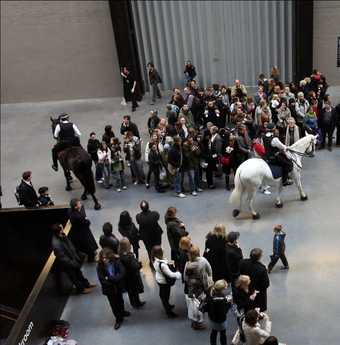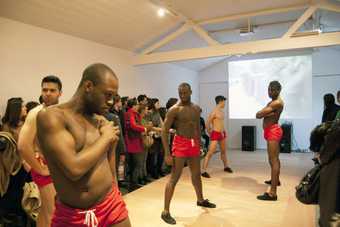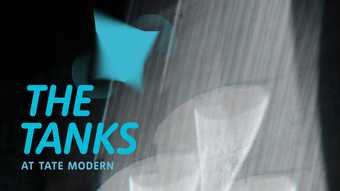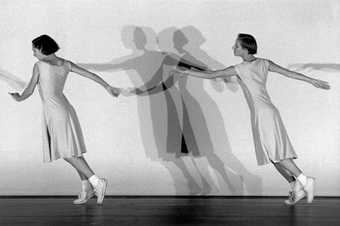It has been said, with a certain amount of ire, that performance, despite its myriad forms, is often treated simply as a novelty turn by commercial galleries, who hire it in to jolly up an opening, while excluding it from day-to-day business. Although art objects enter the fluidity of the market to create a serious financial wake, the amorphousness of live and ephemeral event-based work has, to date, remained curiously immiscible. While it was often the intent of artists of the 1970s to make themselves radically unmarketable, many of today’s practitioners have chosen the form of performance simply because gesture, spoken word, the presence of the body and exchange articulate their ideas more accurately than static objects and images. So the fact that one of Britain’s busiest galleries is dedicating time, space and money to these practices perhaps signals a new attitude across the board. This is not to suggest that performance does not figure at other public institutions around the country – many besides Tate have been running regular live programmes for years – but the plans for the new Tate Modern Tanks spaces symbolise the broader acceptance of something previously considered marginal. In keeping with this game-changing policy, one of the three thematic strands running throughout the Tanks programme will evaluate the ongoing entanglement of art and activism. The romantic image of the artist as transgressive outsider has, through the course of the twentieth century, transmogrified into that of an integrated member of society, not only engaged in political and social systems, but also working towards their improvement.
Although a perhaps questionable universal ethical uprightness is attributed to contemporary artists, there are genuine enclaves where forceful ideological intent motivates practices that, if not actually located within communities, face out towards them from within the gallery, or invite them in to participate. In reconnoitring this terrain, the first symposium of the Tanks programme, ‘The Ethics of Encounter’, approaches issues of impact, aesthetics and methodologies from a number of strategic angles.
Exemplifying the more direct and urgent approach, Jelili Atiku discusses his work in Nigeria, where his sculptural and performance work confronts the government on human rights issues such as prison overpopulation and penal reform. Besides his own practice, which often features the body swathed in abject industrial materials and placed in uncomfortable situations, Atiku is co-founder and co-ordinator of Advocate for Human Rights Through Arts, evidencing an attitude that art can effect real change in Nigeria – an idea that is hotly debated in Europe. While there have been many performative practices adopting an aesthetics of politics without ever leaving the gallery, there is also, conversely, a development within left-wing political activism that looks to art for effective spectacularising or forms such as mass action and relational aesthetics.
‘The Ethics of Encounter’ offers an opportunity to debate the role of the institution within this political landscape. Tate, in particular, has had a variegated recent history with regards to activism. It is an ongoing direct target of critical action by the group Liberate Tate, who request that it rethink its acceptance of funding from BP on account of the oil company’s track record regarding environmental responsibility, and the 2010 Turner Prize was temporarily hijacked, albeit rather contingently, by a ‘teach-in’ conducted by students and staff protesting against budget cuts. Through these disputes the institution is seen to be directly implicated within bio-political structures (in that it becomes instrumental in cleaning up BP’s public image) and entrenched by association, as an authoritative voice and practical enabler within an establishment that is perceived by many to be divisive and elitist. And yet the gallery is also conspicuously intent on education and democratic representation, and supports many artists with political remits and ethical programmes. A debate that resolves some of these paradoxes would be timely when art is influenced by the pull of socially orientated biopolitics and of the neo-liberal markets, employing direct action and indirect referencing.
Suzanne Lacy’s The Crystal Quilt 1987 is a good historical reference point for assessing the potential of art to activate tangentially by way of visibility and audibility. The piece was a tableau performed by 430 women over the age of 60 on Mother’s Day at the IDS Center’s Crystal Court in Minneapolis. The women were dressed in black and sat at tables arranged on a massive rug to resemble a quilt – an effect designed by painter Miriam Schapiro. As they discussed their lives, they changed the position of their arms every ten minutes so that, when viewed from above, the design of the ‘quilt’ would alter. While we have become perhaps over-familiar with ‘relational’ work, Lacy is often overlooked as one of its early formulators, and her immersion in a wider political scene in which actions were directed at US government policy on rape and equal pay, as well as more generalised attitudes to race, gender, sexual orientation and age, provides a useful model for artists wondering how they can affect lived lives now. Tania Bruguera’s ongoing project Immigrant Movement International 2010–15 opens up participation further by way of what she terms ‘useful art”. For IMI the artist inhabits a workshop space in which members of local communities are offered free legal advice, practical workshops, English lessons and other services that help to redress balances of power in societies where meritocratic democracy is failing those with fewer material advantages. It is important to note, though, that ‘The Ethics of Encounter’ is not a soapbox for self-righteous proselytising. Besides their political remit, both Lacy and Bruguera’s pieces have aesthetic, conceptual and narrative concerns. The symposium line-up also evinces a consideration of interpersonal and sexual relationships as a font of empathetic sensuality, particularly for Eddie Peake, whose playful narcissism and eroticism handles gender and sexual politics with a rough exuberance.
The second theme of the Tanks programme spotlights the fragmentary, irrational, disparate and evasive histories interlaced through contemporary performance. The artform is notoriously difficult to ‘capture’ phenomenologically, since descriptions of an event, whether image-based or linguistic, cannot relate absolutely everything. Consequently, the established line on the live event is that it is particular to the specific time and space in which it occurred, and can never be fully represented elsewhere. While this may be the case if precise reconstitution is the aim, there are other modes of filtration and dispersal through which a live event persists, not whole and intact, but as a haunting, perhaps in the form of influence, quotation or stylistic flavouring.
Some pieces presented in the symposium ‘Performance Year Zero’ might be direct reconstructions or reiterations of older works by other artists, but elsewhere the processes of citation, absorption and reaction lie deeper, and these two polar positions – the overt and immanent influence of history – effectively describe a sliding scale along which works can be situated. At one extreme, in 1992 Takashi Murakami remade a number of performances by Japanese avant-garde groups such as Gutai and Hi Red Center. While Gutai originally contracted the body as an expressive tool for image making, Murakami’s reconstructions considered their performances not as formal propositions, but actions defined by Japanese post-war identity. In re-presenting them now, however, they accrue a further layer of contextual significance, particularly in the light of Murakami’s subsequent career in which brands and motifs are central. Rabih Mroué and Lina Sameh, meanwhile, interrogate the model of history as a series of hotspots of types of imagery or styles in Who’s Afraid of Representation. Iconic Western performance images interspersed with imagery of the social and political situation in Lebanon make legible formal parities between the images of avant-garde performance and radical activism, while operational functionalities underpinning the performance image, such as intimacy, precariousness, obstruction and revelation, also become apparent.
Other artists put historical works through a subjective mangle to varying degrees. Keren Cytter reinterprets Dan Graham’s Performer/Audience/ Mirror – in which Graham watched his audience in a mirror and described them to a point of discomfort – bending it across the bar of gender identity, with the surprising subsidiary product of humour. In Moments, dancer and choreographer Boris Charmatz takes as prompts performances by ten female artists, loosely spanning the 1970s, from Simone Forti’s Face Tunes 1967 to Adrian Piper’s Funk Lessons 1983. The outcome, a history of performance in ten acts presented to a small invited audience and later made into a publicly screened film, could be thought of as paradigmatic of live genres: it is subjectively authored and yet laterally inclusive of a historically relegated demographic.
Although not flagged as one of the main curatorial themes, dance emerges as a prevalent subject and form. A second performance by Charmatz, Flip Book, is devised from photographs published in a book on Merce Cunningham’s 50 years of output, while Yvonne Rainer presents a number of works, including Trio A, a mass dance piece that can only be officially performed if learned directly from Rainer or someone she has personally taught, adhering to the oral traditions of folk. The first Focus Project in the South Tank by Anne Teresa De Keersmaeker is a reworking of Fase, Four Movements to the Music of Steve Reich, performed by De Keersmaeker and another female dancer, the sparseserialist music giving momentum to a series of repeating movements that, through their precision, simultaneity and duration, generate an uncanny, almost motorised effect.
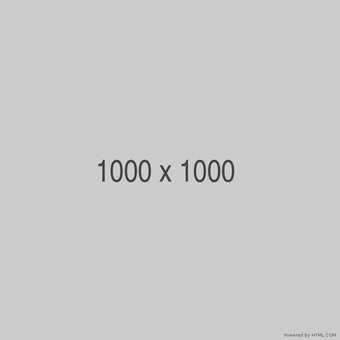
Performance of Tania Bruguera's Tatlin's Whisper #5 in the Turbine Hall at Tate Modern 2008
© Tania Bruguera
Photograph Tate Photography
Controlled discipline and spontaneous mayhem mark the diametric extremes of another polarisation that is particularly pronounced in live performance work. The exact nature of the live event is unknowable until it is already unfolding, and so while an artist such as De Keersmaeker may exercise control through concise choreography and rigorous rehearsal, other artists, such as Bruguera, invite the unknowable into the work by siting the piece within a social space where conditions and attitudes are less predictable and controllable. This presents another obstacle to the museum’s task of representing performance, as such risky outcomes are often off-putting and their historical contexts and narratives confusingly esoteric or simply lost. Consequently, performance art histories are not as monolithic as, say, painting’s; the roots are more entangled and their consolidation into a singular discipline more equivocal. Besides dance and activism, provenance has been variously cited as including action painting, popular theatrical forms such as Commedia dell’Arte, music hall and the contemporary burlesque scene, anti-art movements such as Dada, Fluxus and autodestructive art, as well as popular forms of music and cinema. The third thematic for the Tanks examines expanded cinema – by way of a symposium and Lis Rhodes’s Light Music 1975 installation – with the aim of demonstrating spatial and luminous performativity, and attributing projection with an activating impulse of more than retinal impact.
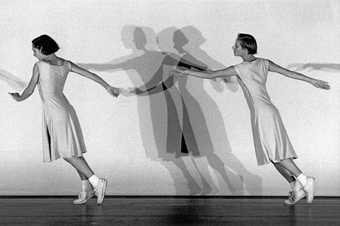
Anne Teresa De Keersmaeker
Fase, Four Movements to the Music of Steve Reich 1982
Performance still
Photo: Herman Sorgeloos
Courtesy Rosas, Brussels
But perhaps the most potent aspect of performance is the live physical encounter and empathy born out of the universal experience of inhabiting a body. The daily disjunction of the private self in public space can be faithfully described or dramatically amplified in the critical relationship between audience and performer, participant and situation. There are those who extrude this from the particularities of their own bodies, as Peake does, and others who, like Haegue Yang, use everyday objects to invoke the every person. Yang’s Dress Vehicles 2011 takes a theatrical cue from Oskar Schlemmer’s triadic ballet, her anthropomorphised Venetian blinds attached to elaborate metal armatures on casters bearing handles that invite interaction and movement. When activated, the Dress Vehicles have a comically limited range of physical motion, while mental associations ripple outwards through the furniture and architecture of commercial and domestic realms, evoking the bizarre atmospherics produced by the banal and prized objects we keep about us in day-to-day life. And it is this retooling of relations, between individuals, bodies, objects and social contexts, which is pivotal to the Tanks programme, as it stretches the ritual cultural form of viewing art in a museum into uncommon configurations to incorporate art that just will not stay still.

